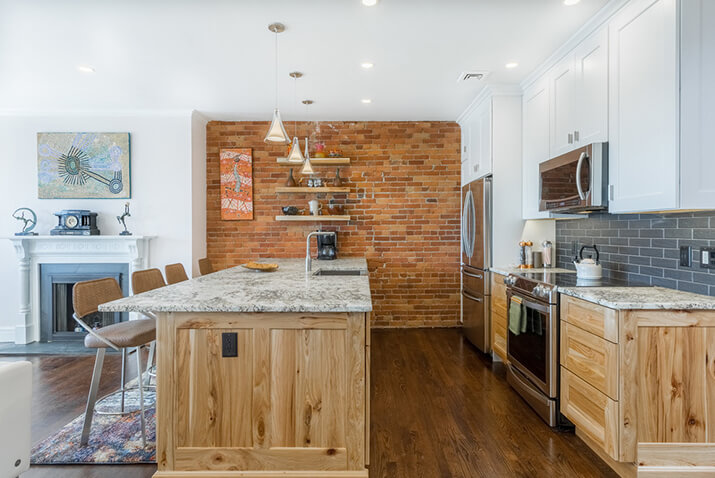“A room should never allow the eye to settle in one place. It should smile at you and create fantasy”
-Juan Montoya
Within the realm of interior design solutions in London, accent walls have evolved into a fundamental element for individuals seeking to metamorphose their living spaces into captivating displays of imagination. Beyond being mere backdrops, accent walls offer a canvas to imbue a room with character, dimension, and aesthetic allure. In the forthcoming article, we will immerse ourselves in the craft of fashioning accent walls. Our journey will encompass an exploration of techniques, accompanied by insights from experts, all aimed at guiding you in the creation of remarkable focal points that redefine the essence of your space.

1. Choosing the Ideal Wall
Before exploring techniques, it’s crucial to choose the right wall for your accent masterpiece. Typically, opt for the wall behind the room’s focal point—like the bedroom’s bed or the living room’s main seating area. Ensure the chosen wall is obstacle-free and provides ample space for your creative vision to flourish. Here are some other practical tips to help with choosing the ideal wall
Consider the scale of the room
When choosing an accent wall, it is important to consider the scale of the room. If you have a small room, you may want to choose a light color or a neutral pattern to avoid overwhelming the space.
Create a focal point
Accent walls are a great way to create a focal point in a room. Place your accent wall behind the sofa, bed, or dining table to draw the eye to the space.
Balance the elements
When creating an accent wall, it is important to balance the elements. Avoid overdoing it with too much color, pattern, or texture. Instead, focus on creating a cohesive and visually appealing look.
Embrace your personal style
Don’t be afraid to experiment and embrace your personal style when creating an accent wall. The most important thing is to choose a design that you love and that reflects your unique personality.
2. Painting Techniques: Adding Depth with Colour
Crafting an accent wall finds remarkable versatility through painting methods. Here are distinct approaches:
Color Blocking:
Employ contrasting hues for painting geometric shapes or sections. This instantly garners a bold, contemporary allure, capturing immediate focus.
Ombre Gradient:
Blend two or more colors seamlessly, producing a gradient effect. Such a gentle transition fosters depth and imparts a tranquil aura.
Stencil Designs:
Opt for varied stencils to fashion intricate patterns or motifs on the wall. This technique introduces artistic nuances to your space.
Solid color:
A solid color is a classic and timeless option for an accent wall. Choose a bold hue to make a statement or a soft hue to create a calming and inviting atmosphere.
Sponge painting:
Sponge painting is a fun and easy way to create a textured accent wall. To sponge paint, simply dip a sponge into the paint and then dab it onto the wall. You can use one color or multiple colors to create different effects.
Two-toned:
A two-toned accent wall is a simple and stylish way to add interest to your space. Choose two complementary colors and paint each half of the wall in a different color

3. Elevating Sensory Engagement with Textured Wall Treatments
Texture is a powerful element that can add depth, interest, and dimension to any space. When used on an accent wall, texture can create a truly stunning focal point that elevates the aesthetics of the room. Infusing your accent wall with textures heightens sensory appeal and elevates aesthetics:
Emulating Natural Elements:
Replicate genuine materials using faux brick or stone veneers. This imparts warmth and character, especially in spaces embracing an industrial or rustic ambiance.
Nature-Inspired Elegance:
Introduce a natural essence with horizontal or vertical wood paneling. The choice of stain or paint imbues your wall with texture and a snug atmosphere.
Adding Dimension:
Opt for sculpted 3D wall panels to introduce depth and curiosity. These panels encompass diverse patterns, ranging from abstract to organically inspired, culminating in an exclusive focal point.
Concrete:
Concrete is a modern and industrial material that can add a touch of edge to your space. You can use real concrete or a concrete-look paint to create a textured accent wall.
Brick:
Brick is another popular choice for creating a textured accent wall. Brick can add a touch of industrial chic or rustic charm to your space.
Tips:
- Consider the overall aesthetic of your room when choosing a texture. Make sure to select a texture that complements the existing décor.
- Balance the elements. Avoid overdoing it with too much texture. Instead, focus on creating a cohesive and visually appealing look.
- Use lighting to highlight the texture of your accent wall. Position a light source so that it casts shadows on the wall, accentuating its texture.
- Protect the texture. If you are using a natural material, such as wood or stone, be sure to seal it to protect it from damage.

4. Wallpaper Wonder: Patterns and Textures
There are endless possibilities for wall covering designs that creates captivating accent walls. With a wide variety of designs, colors, and textures to choose from, you can find the perfect wallpaper to match your personal style and transform any room in your home.
Bold Patterns:
Choose wallpapers with vibrant patterns, such as florals or geometrics, to make a strong visual impact.
Textured Wallpaper:
Explore options like grass cloth, metallic, or fabric-textured wallpapers for a rich tactile experience.
Mural Wallpapers:
Transform your wall into a breathtaking canvas with mural wallpapers depicting landscapes, cityscapes, or artistic scenes.
Tips:
- When choosing wallpaper for your accent wall, be sure to select a wallpaper that is specifically designed for interior walls. You may also want to consider using a primer to help the wallpaper adhere to the wall and create a more even finish.
- Before you start applying the wallpaper, be sure to prepare the wall properly. This includes cleaning the wall and sanding down any rough areas.
- Measure twice, cut once: Before you start cutting the wallpaper, be sure to measure the wall carefully. It is better to have too much wallpaper than not enough.
- Follow the instructions: Be sure to follow the instructions that come with the wallpaper when applying it. Different types of wallpaper require different application methods.
- Be patient: Applying wallpaper can be time-consuming, so be patient and take your time. It is better to do it right the first time than to have to start over.

5. Natural Elements: Bringing the Outdoors In
Infuse your space with the beauty of nature using these techniques:
Living Wall
- Create a living accent wall by installing a vertical garden system. This living masterpiece adds a refreshing and calming effect. There are a variety of vertical garden systems available, so you can choose one that best suits your needs and budget.
- Some systems are designed to be installed indoors, while others are designed for outdoor use. Once you have chosen a system, you will need to select plants that are suitable for your growing conditions. Consider the amount of light your space receives, as well as the temperature and humidity levels.
Exposed Brick or Stone
- Exposed brick or stone walls are a popular way to add character and charm to any space. They can create a warm and inviting atmosphere, or a cool and industrial vibe. If you have original brick or stone walls in your home, you can uncover them by removing the drywall or plaster that is covering them.
- This can be a DIY project, but it is important to take precautions to avoid damaging the walls or creating dust. If you do not have original brick or stone walls, you can add a veneer to create a similar look. Veneers are thin slices of brick or stone that are bonded to the existing wall. Veneers are available in a variety of colors and textures, so you can choose one that matches your style and décor.
Wood Slices:
- Wood slices are a versatile and affordable material that can be used to create a variety of home décor projects. They are also a great way to add a touch of nature to your space. One of the most popular ways to use wood slices is to create an accent wall.
- This is a unique and eye-catching way to add personality to your home. Once you have gathered your wood slices, you can begin arranging them in a mosaic pattern on the wall. You can use a variety of different patterns, such as herringbone, chevron, or random.
Unleash your creativity through accent walls that redefine your space. Whether you explore colour-rich painting techniques, engage tactile senses with textures, narrate stories with vibrant wallpapers, or evoke nature’s essence, the possibilities abound. As you embark on this journey, harmonize your accent wall’s uniqueness with the room’s overarching theme. Achieve a symbiotic blend of distinction and harmony that seamlessly integrates your accent wall into the room’s design.
With the expertise and guidance of an interior design studio in London, let your imagination soar, experiment boldly, and metamorphose plain walls into captivating masterpieces that mirror your style, reimagining your living spaces. Interior design professionals can help you transform your vision into reality, ensuring that your accent walls not only stand out but also complement the overall aesthetic of your home.
Elevate your space with Oraanj Interior Design, mastering the art of Accent Walls. Our expertise turns walls into statements, blending creativity and sophistication. Redefine your surroundings with our unique touch.
Author: Trushna Agale and Oluwatomi Olaosebikan (Interior Designer)

